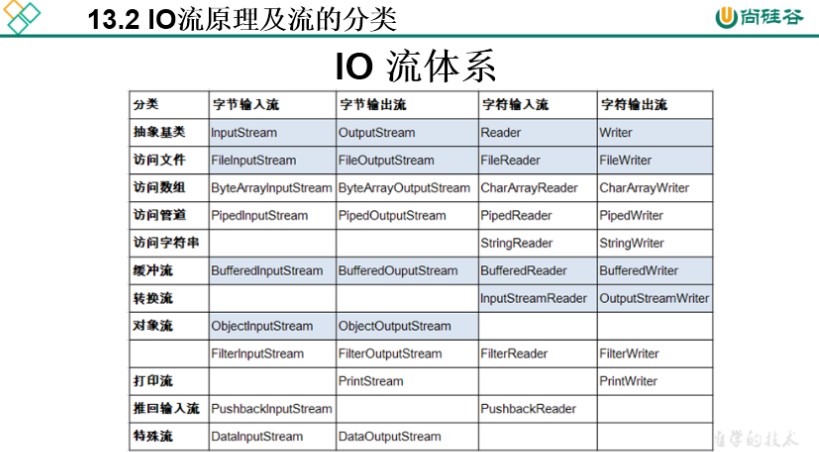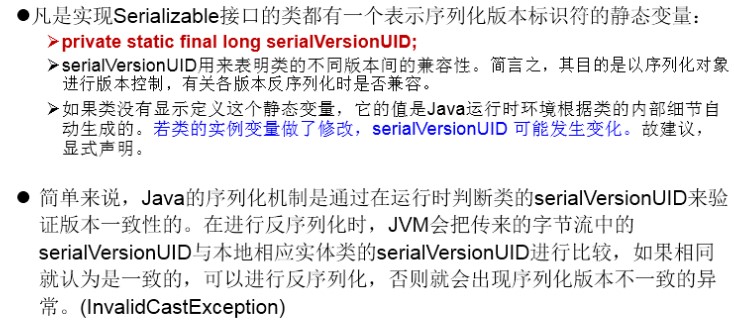IO流体系结构
File类的使用
1.File类的一个对象,代表一个个文件或一个文件目录(俗称:文件夹)
2.File类声明在java.io包下
3.File类中涉及到关于文件或文件目录的创建、删除、重命名、修改时间、文件大小等方法,并未涉及到写入或读取文件内容的操作。如果需要读取或写入文件内容,必须使用IO流来完成
4.后续File类的对象常会作为参数传递到流的构造器中,指明读取或写入的“终点”
创建File类的实例
File(String filePath)
File(String parentPath,String childPath)
File(File parentFile,String childPath)
public void test1(){//构造器1File file1 = new File("hello.txt");//相对于当前moduleFile file2 = new File("F:\\code\\day01\\hi.txt");//构造器2File file3 = new File("F:\\code","day01");//构造器3File file4 = new File(file3,"hi.txt");}
路径分类
相对路径:相较于某个路径下,指明的路径
绝对路径:包含盘符在内的文件或文件目录的路径
路径分隔符
File类常用方法

public void test2(){File file1 = new File("hello.txt");File file2 = new File("E:\\IO\\hi.txt");System.out.println(file1.getAbsolutePath());System.out.println(file1.getPath());System.out.println(file1.getName());System.out.println(file1.getParent());System.out.println(file1.length());System.out.println(file1.lastModified());System.out.println();System.out.println(file2.getAbsolutePath());System.out.println(file2.getPath());System.out.println(file2.getName());System.out.println(file2.getParent());System.out.println(file2.length());System.out.println(file2.lastModified());}
public void test3(){//如下的两个方法适用于文件目录//文件需真实存在File file = new File("F:\\code\\daily");String[] list = file.list();for (String s : list){System.out.println(s);}File[] files = file.listFiles();for (File f : files){System.out.println(f.toString());}}
public void test4(){//要想保证返回true,需要file1在硬盘存在,且file2不能存在File file1 = new File("hello.txt");File file2 = new File("E:\\IO\\hi.txt");boolean renameTo = file1.renameTo(file2);System.out.println(renameTo);}
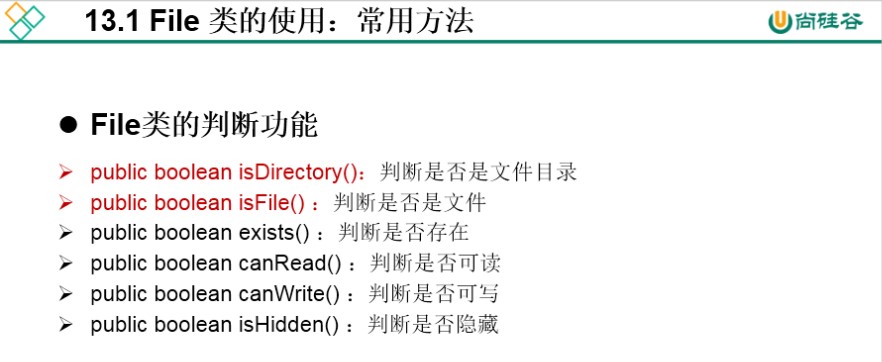
public void test5(){File file1 = new File("hello.txt");System.out.println(file1.isDirectory());System.out.println(file1.isFile());System.out.println(file1.exists());System.out.println(file1.canRead());System.out.println(file1.canWrite());System.out.println(file1.isHidden());System.out.println();File file2 = new File("E:\\IO");System.out.println(file2.isDirectory());System.out.println(file2.isFile());System.out.println(file2.exists());System.out.println(file2.canRead());System.out.println(file2.canWrite());System.out.println(file2.isHidden());}
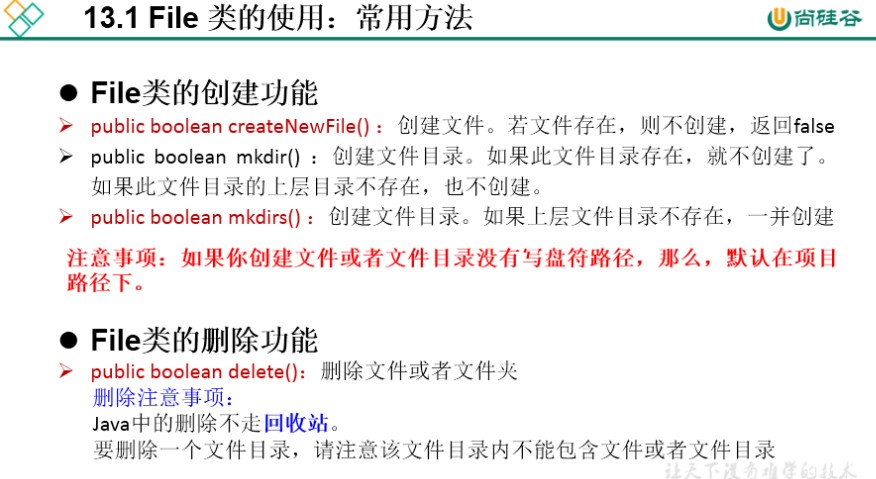
public void test6() throws IOException {//文件创建File file1 = new File("hi.txt");if (!file1.exists()){file1.createNewFile();System.out.println("创建成功");}else{file1.delete();System.out.println("删除成功");}}@Testpublic void test7(){//文件目录的创建File file1 = new File("e:\\IO\\io1\\io3");boolean mkdir = file1.mkdir();if (mkdir) {System.out.println("创建成功1");}File file2 = new File("e:\\IO\\io1\\io4");boolean mkdir1 = file2.mkdirs();if (mkdir1) {System.out.println("创建成功2");}}
IO流
流的分类
1.操作数据单位:字节流、字符流
2.数据的流向:输入流、输出流
3.流的角色:节点流、处理流
流的体系结构
抽象基类 节点流 缓冲流
InputStream FileInputStream BufferedInputStream
OutputStream FileOutputStream BufferedOutputStream
Reader FileReader BufferedReader
Witer FileWriter BufferedWriter
FileReader读入数据操作
说明:
1.read()的理解:返回读入的一个字符。如果达到文件末尾,返回-1
2.异常处理:为了保证流资源一定可以执行关闭操作,需要使用try-catch-finally处理
3.读入的文件一定要存在,否则就会报FileNotFoundException
public void testFileReader(){FileReader fr = null;try {//1.实例化File类的对象,指明要操作的文件File file = new File("hello.txt");//2.提供具体的流fr = new FileReader(file);//3.数据的读入//read():返回读入的一个字符。如果达到文件末尾,返回-1//方式一/*int data = fr.read();while (data != -1){System.out.println((char)data);data = fr.read();}*///方式二 语法上针对于方式一的修改int data;while ((data = fr.read()) != -1){System.out.println((char) data);}} catch (IOException e) {e.printStackTrace();}finally {//4.流的关闭操作try {if (fr != null)fr.close();} catch (IOException e) {e.printStackTrace();}}}
使用read(char[] cbuf)读入数据
public void testFileReader1() {FileReader fr = null;try {//1.File类的实例化File file = new File("hello.txt");//2.FileReader流的实例化fr = new FileReader(file);//3.读入的操作//read(char[] cbuf):返回每次读入cbuf数组中的字符个数,如果达到文件末尾,返回-1char[] cbuf = new char[5];int len;while ((len = fr.read(cbuf)) != -1){//方式一://错误的写法/* for (int i =0;i < cbuf.length;i++){System.out.print(cbuf[i]);}*///正确的写法for (int i =0;i < len;i++){System.out.print(cbuf[i]);}//方式二://错误的写法/*String str = new String(cbuf);System.out.print(str);*///正确的写法String str = new String(cbuf,0,len);System.out.print(str);}} catch (IOException e) {e.printStackTrace();}finally {if (fr != null)try {//4.资源关闭fr.close();} catch (IOException e) {e.printStackTrace();}}}
FileWriter写出数据操作
说明:
1.输出操作,对应的File可以不存在。并不会报异常
2.File对应的硬盘中的文件如果不存在,输出的过程中,会自动创建此文件
File对应的硬盘中的文件如果存在:
如果流使用的构造器是:FileWriter(file,false)/FileWriter(file):对原有文件的覆盖
如果流使用的构造器是:FileWriter(file,true):不会对原有文件覆盖,而是在原有文件基础上追加内容
public void testFileWriter() {FileWriter fw = null;try {//1.提供File类的对象,指明写出到的文件File file = new File("hello1.txt");//2.提供FileWriter的对象,用于数据的写出fw = new FileWriter(file);//3.写出的操作fw.write("I have a dream!\n");fw.write("You need to have a dream!");} catch (IOException e) {e.printStackTrace();} finally {//4.流资源关闭try {if (fw != null){fw.close();}} catch (IOException e) {e.printStackTrace();}}}
FileReader和FileWriter实现文本的复制
public void testFileReaderFileWriter() {FileReader fr = null;FileWriter fw = null;try {//1.创建File类的对象,指明读入和写出的文件File srcFile = new File("hello.txt");File destFile = new File("hello2.txt");//2.创建输入流和输出流的对象fr = new FileReader(srcFile);fw = new FileWriter(destFile);//3.数据的读入和写出操作char[] cbuf = new char[5];int len;//记录每次读入到cbuf数组中的字符的个数while ((len = fr.read(cbuf)) != -1){//每次写出len个字符fw.write(cbuf,0,len);}} catch (IOException e) {e.printStackTrace();} finally {//4.关闭流资源try {if (fw != null)fw.close();} catch (IOException e) {e.printStackTrace();}try {if (fr != null)fr.close();} catch (IOException e) {e.printStackTrace();}}}
FileInputStream和FileOutputStream的使用
结论:
1.文本文件(.txt , .java , .c , .cpp),使用字符流处理
2.非文本文件(.jpg , .mp3 , .avi , .doc , .ppt , …),使用字节流处理
FileInputStream和FileOutputStream读写文本文件
public void testFileInputStream() {//使用字节流FileInputStream处理文本文件,可能出现乱码FileInputStream fis = null;try {//1.造文件File file = new File("hello.txt");//2.造流fis = new FileInputStream(file);//3.读数据byte[] buffer = new byte[5];int len;//记录每次读取的字节的个数while((len = fis.read(buffer)) != -1){String str = new String(buffer,0,len);System.out.print(str);}} catch (IOException e) {e.printStackTrace();} finally {if (fis != null) {//4.关闭资源try {fis.close();} catch (IOException e) {e.printStackTrace();}}}}
FileInputStream和FileOutputStream读写非文本文件
public void testFileInputOutputStream() {FileInputStream fis = null;FileOutputStream fos = null;try {File srcFile = new File("记.jpg");File destFile = new File("记1.jpg");fis = new FileInputStream(srcFile);fos = new FileOutputStream(destFile);//复制过程byte[] buffer = new byte[5];int len;while((len = fis.read(buffer)) != -1){fos.write(buffer,0,len);}} catch (IOException e) {e.printStackTrace();} finally {if (fos != null){try {fos.close();} catch (IOException e) {e.printStackTrace();}}if (fis != null){try {fis.close();} catch (IOException e) {e.printStackTrace();}}}}
FileInputStream和FileOutputStream复制文件
//指定路径下文本的复制public void copyFile(String srcPath,String destPath){FileInputStream fis = null;FileOutputStream fos = null;try {File srcFile = new File(srcPath);File destFile = new File(destPath);fis = new FileInputStream(srcFile);fos = new FileOutputStream(destFile);//复制过程byte[] buffer = new byte[5];int len;while((len = fis.read(buffer)) != -1){fos.write(buffer,0,len);}} catch (IOException e) {e.printStackTrace();} finally {if (fos != null){try {fos.close();} catch (IOException e) {e.printStackTrace();}}if (fis != null){try {fis.close();} catch (IOException e) {e.printStackTrace();}}}}@Testpublic void testCopyFile(){long start = System.currentTimeMillis();String srcPath = "hello.txt";String destPath = "hello3.txt";copyFile(srcPath,destPath);long end = System.currentTimeMillis();System.out.println("复制操作花费的时间为:" + (end - start));}
缓冲流的使用
实现非文本文件的复制
使用BufferedInputStream和BufferedOutputStream
public void test1() throws FileNotFoundException {FileInputStream fis = null;FileOutputStream fos = null;BufferedInputStream bis = null;BufferedOutputStream bos = null;try {//1.造文件File srcFile = new File("记.jpg");File destFile = new File("记2.jpg");//2.造流//2.1 造节点流fis = new FileInputStream((srcFile));fos = new FileOutputStream((destFile));//2.2 造缓冲流bis = new BufferedInputStream((fis));bos = new BufferedOutputStream((fos));//3.复制的细节:读取、写入byte[] buffer = new byte[10];int len;while ((len = bis.read(buffer)) != -1){bos.write(buffer,0,len);}} catch (IOException e) {e.printStackTrace();} finally {//4.资源关闭//要求:先关闭外层的流,再关闭内层的流if (bos != null){try {bos.close();} catch (IOException e) {e.printStackTrace();}}if (bis != null){try {bis.close();} catch (IOException e) {e.printStackTrace();}}//说明:关闭外层流的同时,内层流也会自动进行关闭。关于内层流的关闭,我们可以省略/*fos.close();fis.close();*/}
实现文本文件复制
使用BufferedReader和BufferedWriter
public void testBufferedReaderBufferedWriter(){BufferedReader br = null;BufferedWriter bw = null;try {//创建文件和相应的流br = new BufferedReader(new FileReader(new File("hello.txt")));bw = new BufferedWriter(new FileWriter(new File("hello4.txt")));//读写操作//方式一:使用char[]数组/*char[] cbuf = new char[1024];int len;while ((len = br.read(cbuf)) != -1 ){bw.write(cbuf,0,len);//bw.flush();}*///方式二:使用StringString data;while((data = br.readLine()) != null){//方法一:bw.write(data + "\n");//data中不包含换行符//方法二:bw.write(data);//data中不包含换行符bw.newLine();}} catch (IOException e) {e.printStackTrace();} finally {//关闭资源if (bw != null){try {bw.close();} catch (IOException e) {e.printStackTrace();}}if (br != null){try {br.close();} catch (IOException e) {e.printStackTrace();}}}}
练习
图片加密
解密:将fis与fos中文件相互交换即可完成
public void test2(){FileInputStream fis = null;FileOutputStream fos = null;try {fis = new FileInputStream("记.jpg");fos = new FileOutputStream("记secret.jpg");byte[] buffer = new byte[20];int len;while ((len = fis.read(buffer)) != -1){//字节数组进行修改//错误的/*for (byte b : buffer){b = (byte) (b ^ 5);}*///正确的for (int i = 0;i < len;i++){buffer[i] = (byte) (buffer[i] ^ 5 );}fos.write(buffer,0,len);}} catch (IOException e) {e.printStackTrace();} finally {if (fis != null){try {fis.close();} catch (IOException e) {e.printStackTrace();}}if (fos != null){try {fos.close();} catch (IOException e) {e.printStackTrace();}}}}
转换流的使用
1.转换流:属于字符流
InputStreamReader:将一个字节的输入流转换为字符的输入流
OutputStreamWriter:将一个字符的输出流转换为字节的输出流
2.作用:提供字节流与字符流之间的转换
3.解码:字节、字节数组 —-> 字符数组、字符串
编码:字符数组、字符串 —-> 字节、字节数组
public void test1() {InputStreamReader isr = null;try {FileInputStream fis = new FileInputStream("hello.txt");//参数二指明了字符集,具体使用哪个字符集,取决于文件保存时使用的字符集isr = new InputStreamReader(fis,"UTF-8");//InputStreamReader isr = new InputStreamReader(fis);//使用系统默认的字符集char[] cbuf = new char[20];int len;while((len = isr.read(cbuf)) != -1){String str = new String(cbuf,0,len);System.out.println(str);}} catch (IOException e) {e.printStackTrace();} finally {if (isr != null){try {isr.close();} catch (IOException e) {e.printStackTrace();}}}}
实现读入与写出
public void test2() {InputStreamReader isr = null;OutputStreamWriter osw = null;try {File file1 = new File("hello.txt");File file2 = new File("hello_gbk.txt");FileInputStream fis = new FileInputStream(file1);FileOutputStream fos = new FileOutputStream(file2);isr = new InputStreamReader(fis, "UTF-8");osw = new OutputStreamWriter(fos, "gbk");char[] cbuf = new char[20];int len;while ((len = isr.read(cbuf)) != -1) {osw.write(cbuf, 0, len);}} catch (IOException e) {e.printStackTrace();} finally {if (isr != null){try {isr.close();} catch (IOException e) {e.printStackTrace();}}if (osw != null){try {osw.close();} catch (IOException e) {e.printStackTrace();}}}}
字符集
对象流
序列化过程
将内存中的java对象保存到磁盘中或通过网络传输出去
使用ObjectOutputStream实现
public void test1(){ObjectOutputStream oos = null;try {oos = new ObjectOutputStream(new FileOutputStream("object.txt"));oos.writeObject(new String("我爱北京"));oos.flush();//刷新操作} catch (IOException e) {e.printStackTrace();} finally {if (oos != null){try {oos.close();} catch (IOException e) {e.printStackTrace();}}}}
反序列化过程
将磁盘文件中的对象还原为内存中的一个Java对象
使用ObjectInputStream实现
public void test2(){ObjectInputStream ois = null;try {ois = new ObjectInputStream(new FileInputStream("object.txt"));Object obj = ois.readObject();String str = (String) obj;System.out.println(str);} catch (IOException e) {e.printStackTrace();} catch (ClassNotFoundException e) {e.printStackTrace();} finally {if (ois != null){try {ois.close();} catch (IOException e) {e.printStackTrace();}}}}
自定义类的序列化与反序列化操作
自定义类的要求
1.需要实现接口:Serializable
2.当前类提供一个全局变量:serialVersionUID
3.除了当前类需要实现Serializable接口之外,还必须保证其内部所有属性也必须是可序列化的(默认情况下,基本数据类型可序列化)
补:ObjectOutputStream和ObjectInputStream不能序列化static和transient修饰的成员变量
过程与序列化和反序列化一致
serialVersionUID的说明
RandomAccessFile的使用
1.RandomAccessFile直接继承于java.lang.Object类,实现了DataInput和DataOutput接口
2.RandomAccessFile既可以作为一个输入流,又可以作为一个输出流
3.如果RandomAccessFile作为输出流时,写出到文件如果不存在,则在执行过程中自动创建,如果写出到文件存在,则会对原有文件内容进行覆盖。(默认情况下从头覆盖)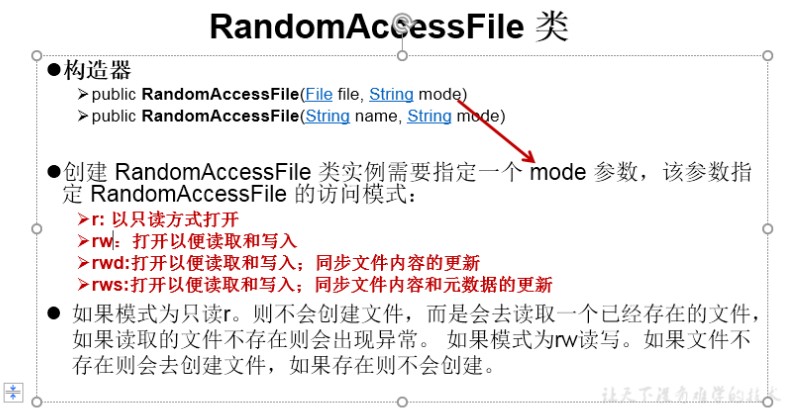
实现读取与写入操作
public void test1() {RandomAccessFile raf1 = null;RandomAccessFile raf2 = null;try {raf1 = new RandomAccessFile(new File("data.txt"),"r");raf2 = new RandomAccessFile(new File("data1.txt"),"rw");byte[] buffer = new byte[10];int len;while((len = raf1.read(buffer)) != -1){raf2.write(buffer,0,len);}} catch (IOException e) {e.printStackTrace();} finally {if (raf1 != null){try {raf1.close();} catch (IOException e) {e.printStackTrace();}}if (raf2 != null){try {raf2.close();} catch (IOException e) {e.printStackTrace();}}}}
实现数据的插入
public void test2() {RandomAccessFile raf1 = null;try {raf1 = new RandomAccessFile("hello.txt","rw");raf1.seek(3);//将指针调到角标为3的位置//保存指针3后面的所有数据到StringBuilder中StringBuilder builder = new StringBuilder((int) new File("hello.txt").length());byte[] buffer = new byte[20];int len;while ((len = raf1.read(buffer)) != -1){builder.append(new String(buffer,0,len));}//调回指针,写入”xyz“raf1.seek(3);raf1.write("xyz".getBytes(StandardCharsets.UTF_8));//将StringBuilder中的数据写入到文件中raf1.write(builder.toString().getBytes(StandardCharsets.UTF_8));} catch (IOException e) {e.printStackTrace();} finally {if (raf1 != null){try {raf1.close();} catch (IOException e) {e.printStackTrace();}}}}
其他流的使用
标准流的输入、输出流
1.System.in:标准的输入流,默认从键盘输入
System.out:标准的输出流,默认从控制台输出
2.System类的setIn(InputStream is) / setOut(PrintStream ps)重新指定输入和输出流
实例:将读取到的整行字符串转成大写输出,直至当输入”e“或”exit“时,退出程序
方法一:使用Scanner实现,调用next()返回一个字符串
方法二:使用System.in实现。System.in —-> 转换流 —-> BufferedReader的readLine()
//方法二public class OtherStreamTest {public static void main(String[] args) {BufferedReader br = null;try {InputStreamReader isr = new InputStreamReader(System.in);br = new BufferedReader(isr);while (true) {System.out.println("请输入字符串:");String data = br.readLine();if ("e".equalsIgnoreCase(data) || "exit".equalsIgnoreCase(data)){System.out.println("程序结束");break;}String upperCase = data.toUpperCase();System.out.println(upperCase);}} catch (IOException e) {e.printStackTrace();} finally {if (br != null){try {br.close();} catch (IOException e) {e.printStackTrace();}}}}}
打印流
PrintStream和PrintWriter 都是输入流
提供了一系列重载的print()和println()
数据流
DataInputStream和DataOutputStream
作用:用于读取或写出基本数据类型的变量或字符串
实例:
注意:读取不同类型的数据的顺序要与当初写入文件时,保存的数据的顺序一致
public void test1(){DataOutputStream dos = null;try {dos = new DataOutputStream(new FileOutputStream("data.txt"));dos.writeUTF("Y三角");dos.writeInt(19);dos.writeBoolean(true);} catch (IOException e) {e.printStackTrace();} finally {if (dos != null){try {dos.close();} catch (IOException e) {e.printStackTrace();}}}}public void test2() throws IOException {//将文件中存储的基本数据类型变量和字符串读取到内存中,保存在变量中DataInputStream dis = new DataInputStream(new FileInputStream("data.txt"));String name = dis.readUTF();int age = dis.readInt();boolean isMale = dis.readBoolean();System.out.println("name:" + name);System.out.println("age:" + age);System.out.println("isMale:" +isMale);dis.close();}
